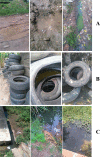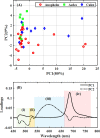Water quality assessment in mosquito breeding habitats based on dissolved organic matter and chlorophyll measurements by laser-induced fluorescence spectroscopy
- PMID: 35895685
- PMCID: PMC9328511
- DOI: 10.1371/journal.pone.0252248
Water quality assessment in mosquito breeding habitats based on dissolved organic matter and chlorophyll measurements by laser-induced fluorescence spectroscopy
Abstract
Rapid urbanization and its associated pollution can affect water quality in mosquito breeding habitats and, as a result, the ecology and control of mosquito vectors. To understand the effects of pollution on mosquito vectors, an accurate assessment of water quality in breeding habitats is needed. Presently, water quality assessment of mosquito breeding habitats is usually based on the measurement of individual physicochemical parameters. However, several parameters are sometimes difficult to interpret or may not give a clear picture of the overall water quality of the breeding habitats, especially when the pollutants are in complex mixtures. This study employed the use of Laser-Induced Fluorescence (LIF) spectroscopy to assess water quality in breeding habitats of Anopheles, Aedes, and Culex mosquitoes in urban areas in Cape Coast, Ghana. The LIF spectra, using a 445-nm diode laser, were measured from field-collected water samples in the laboratory. The LIF spectra showed the presence of dissolved organic matter (DOM) and chlorophyll in the breeding habitats. The DOM and chlorophyll fluorescence signals were normalised by the Raman vibrational signals to determine water quality in each habitat. The overall water quality was better in Aedes breeding habitats than in Anopheles and Culex breeding habitats. The poor water quality in Anopheles and Culex breeding habitats was due to the presence of high fulvic acid and chlorophyll content, which often reflect pollutants from anthropogenic sources. Anopheles and Aedes habitats were made up of mainly An. coluzzii and Ae. aegypti respectively while Culex species were identified to genus level. The results add up to the growing concern about the breeding of Anopheles in polluted habitats. The study demonstrated for the first time the ability of LIF spectroscopy to assess water quality in mosquito breeding habitats.
Conflict of interest statement
The authors have declared that no competing interests exist.
Figures







References
-
- World Health Organization. WHO Factsheet Vector-borne diseases. Factsheet number 387. 2014.
-
- Service M. Medical Entomology for Students. Medical Entomology for Students, Fourth Edition. Cambridge: Cambridge University Press; 2008. doi: 10.1017/CBO9780511811012 - DOI
-
- Jeanrenaud ACSN, Brooke BD, Oliver S V. Second generation effects of larval metal pollutant exposure on reproduction, longevity and insecticide tolerance in the major malaria vector Anopheles arabiensis (Diptera: Culicidae). Parasites Vectors. 2020;13: 1–11. doi: 10.1186/S13071-020-3886-9 - DOI - PMC - PubMed
MeSH terms
Substances
LinkOut - more resources
Full Text Sources

